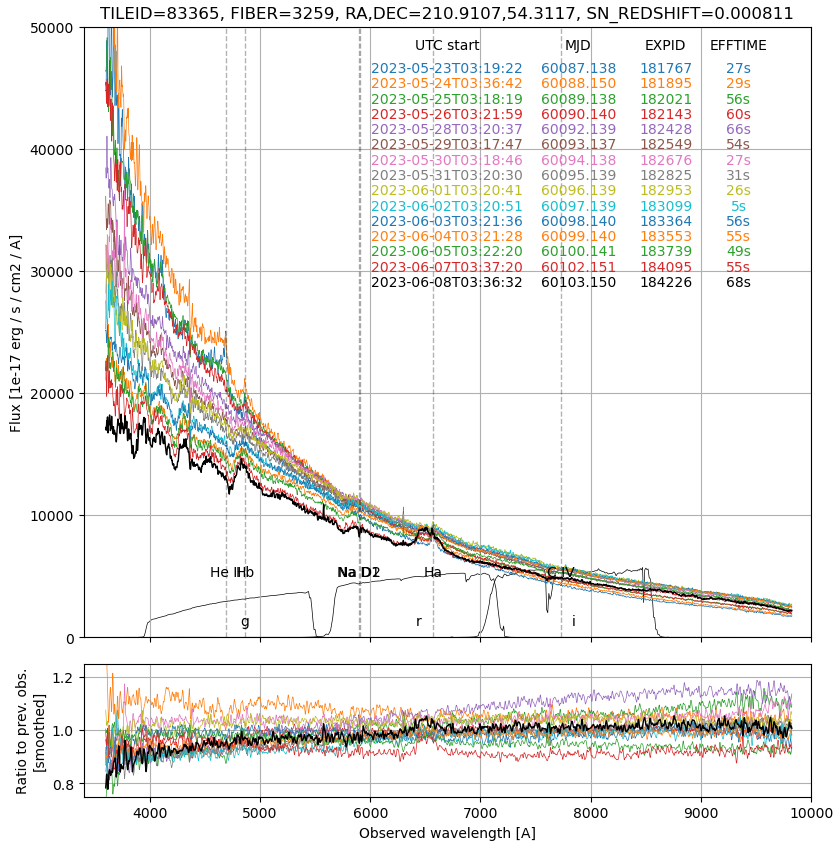Dillon Brout, Harvard University
June 16, 2023
The universe (and especially Messier 101) never ceases to amaze us. Recently, a remarkable Type II supernova event unfolded in the nearby “Pinwheel galaxy” (M101), captivating astronomers worldwide. We are just 12 years removed from the famed supernova 2011fe residing in M101 and that sparked its own paradigm shift for studies of supernovae. The one that occurred this past week, dubbed SN2023ixf, promises to offer a wealth of new scientific insights due to its exceptional characteristics and close proximity. This presents a rare opportunity to delve deeper into the mysteries of stellar explosions and gain a better understanding of their relation, formation, and interaction with their environments; and the DESI is on the case!
Why is this rare event so useful?
Type II supernovae occur when massive stars exhaust their nuclear fuel and undergo a catastrophic collapse, resulting in a brilliant explosion. These colossal explosions release an enormous amount of energy and because this occurred in one of the closest galaxies to our own (M101 is a mere 21 million light-years away) it is extremely bright in astronomical standards. Furthermore, the proximity of this supernova offers an unprecedented opportunity for astronomers to study its evolution from start to finish in great detail, unlike many other supernovae that occur in more distant galaxies. We can see the star as it was before its death and eventually peer into the aftermath.
What is a Type II Supernova?
Type II supernovae, like SN2023ixf, have distinctive characteristics that set them apart from other types of supernovae. These explosions occur when the star’s core collapses under its own gravity, leading to a rebound that creates a powerful shockwave. This shockwave blasts away the outer layers of the star, generating a brilliant burst of light. As the ejected material interacts with the surrounding medium, it produces various elements, enriching the cosmos with carbon and oxygen, crucial for life itself. They are primarily identified by the presence of hydrogen lines in their spectra, which signifies the explosion of massive stars that still contain substantial amounts of this elemental gas. By analyzing the spectroscopic signatures of these supernovae in detail, astronomers can glean valuable information about the nature of the progenitor star, the explosion dynamics, and the elements synthesized during the event.
What is DESI’s Role?
DESI is uniquely positioned to witness and document the evolution of SN2023ixf through careful analysis of its spectrum. We can take advantage of the twilight time before the night sky is fully dark, because the supernova is so near and so exceptionally bright, DESI can gather crucial data without impacting the regular survey operations. So we will be monitoring the spectrum of SN2023ixf continuously, especially during all phases of the moon when other spectrographs around the world will in many cases be swapped out for infrared instruments (due to the optical brightness of the moon).

The continuous, uniform, and highly calibrated data acquired by DESI during this remarkable event will provide one of the highest quality datasets ever acquired for a type II supernova. This can be seen in the included Figure (raw data). We have been taking data every night since May 23rd just before it peaked in brightness. One can see different elements of the spectral features evolving over time. In the bottom panel is the ratio of the spectra which suggests that the supernova is getting redder over time. Such data will enable us to address outstanding scientific questions and explore intriguing possibilities. For instance, the extended observations of SN2023ixf over the next few days and weeks may offer insights into the interaction between the supernova ejecta and the surrounding medium. This scenario could potentially yield observations of shock waves, collisions, or even the formation of exotic elements through nucleosynthesis. In addition, the exceptional quality of DESI’s flux calibration will significantly contribute to the accuracy and reliability of the dataset when comparing features of the spectrum across different nights and observing conditions.
By harnessing the power of DESI, we will be closely monitoring and will be ready should something unexpected happen with SN2023ixf!